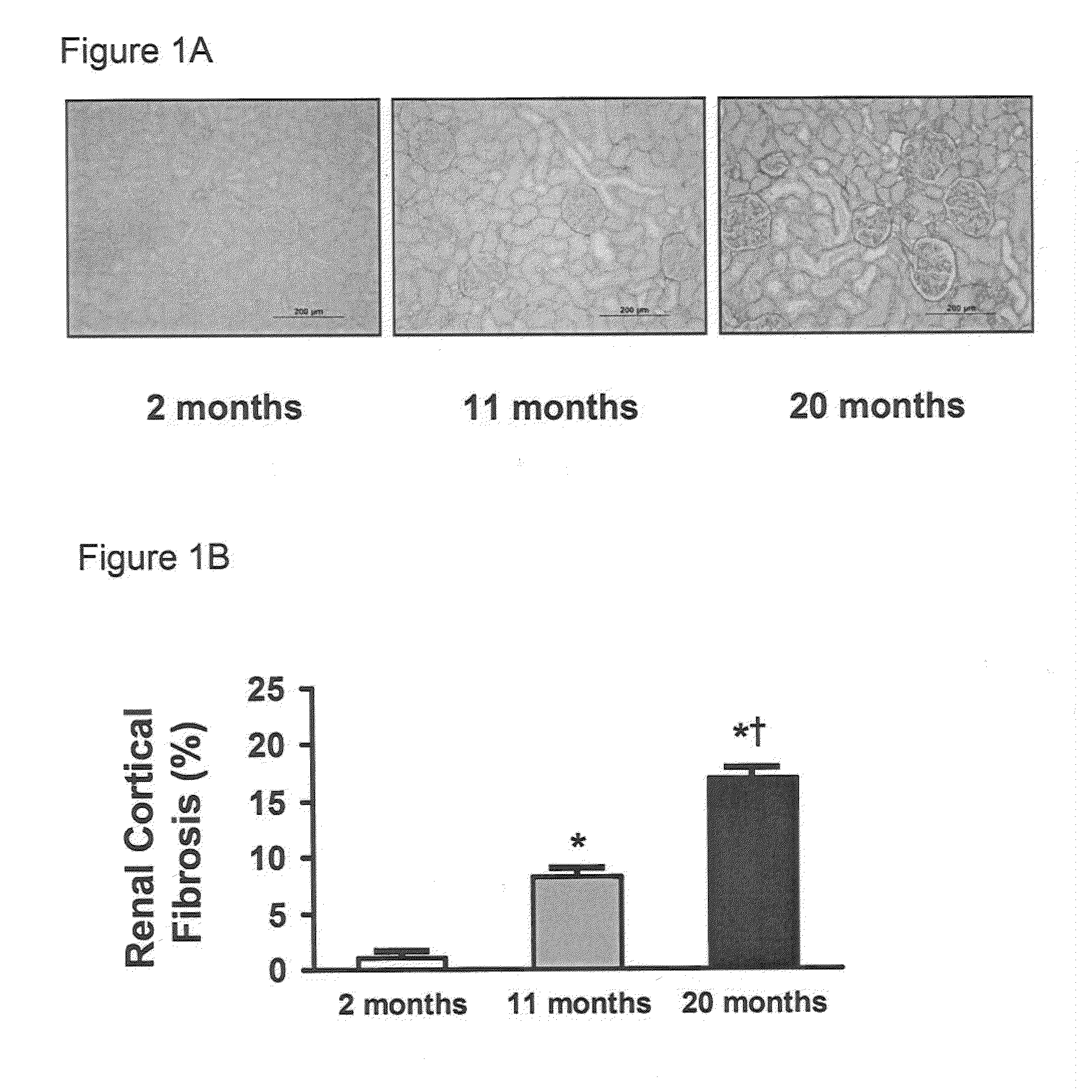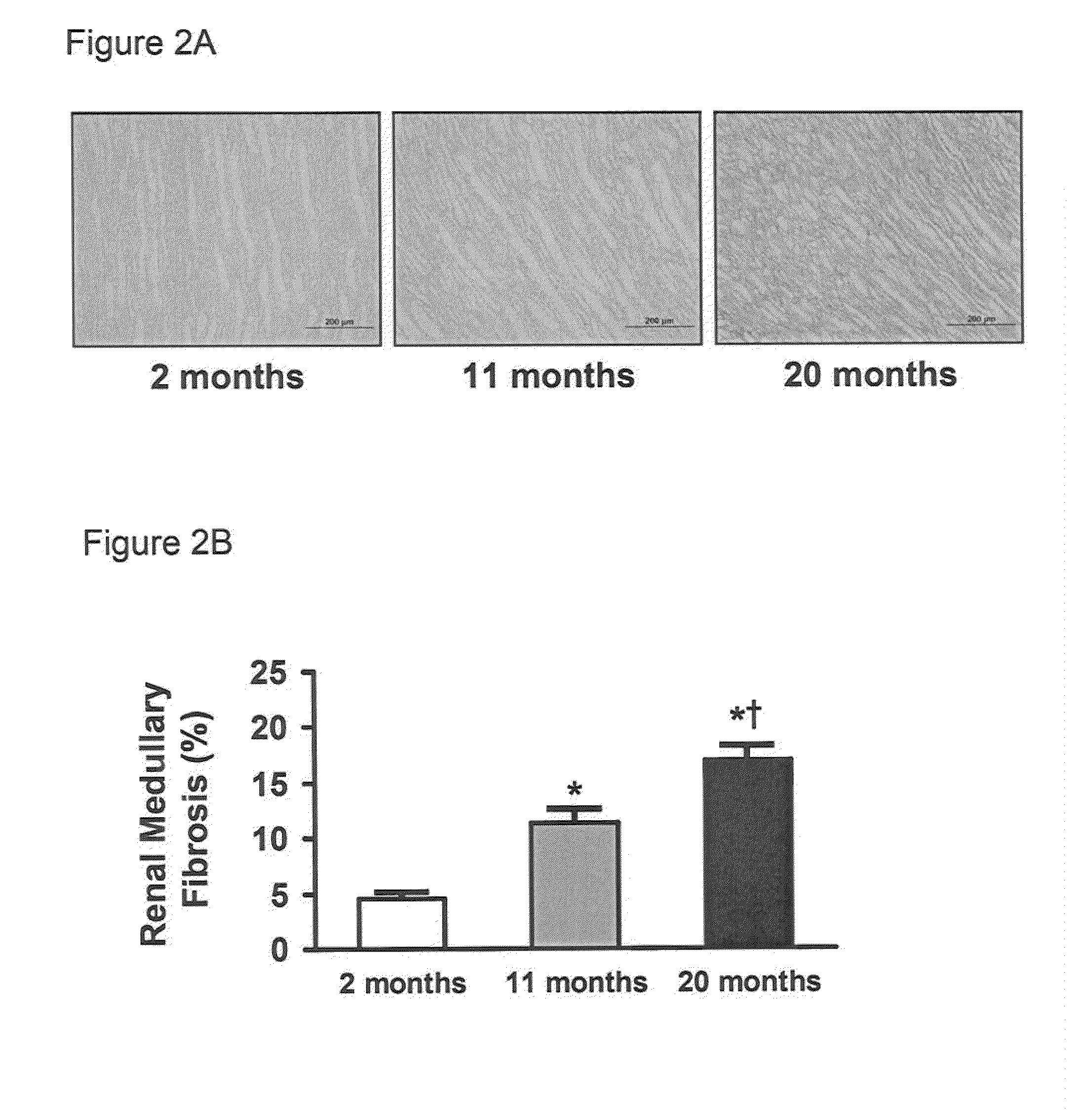Assessing renal structural alterations and outcomes
a technology of applied in the field of assessment of renal structural alterations and outcomes, can solve the problems of poor outcome, poor outcome, poor outcome, kidney failure, cardiac function, kidney failure, etc., and achieve the effect of increasing likelihood, increasing likelihood, and increasing the level of urinary cnp
- Summary
- Abstract
- Description
- Claims
- Application Information
AI Technical Summary
Benefits of technology
Problems solved by technology
Method used
Image
Examples
example 1
Use of Urinary CNP Excretion as Biomarker for Renal Fibrosis During Aging
Animals
[0056]Studies were performed in 2, 11, and 20 month old male Fischer rats (Harlan Laboratories, Inc., Madison, Wis., n=8-10 per age group, unless otherwise specified). The experimental study was performed in accordance with the Animal Welfare Act and with approval of the Mayo Clinic Institutional Animal Care and Use Committee.
Human Renal Biopsy Tissue
[0057]Human kidney tissue was obtained from core needle biopsy specimens from healthy living kidney donors at the time of kidney donation as described elsewhere (Rule et al., Ann. Intern. Med., 152:561-567 (2010)). A total of six paraffin-embedded renal biopsy specimens were examined in this study. The young group consisted of three female donors with mean age of 19 years old (age range 18 to 20 years old) and old group consisted of three 71 year old female donors.
24 Hours Urine Collection
[0058]Rats were placed in metabolic cages with free access to food and...
example 2
CNP is a Urinary Biomarker with Prognostic Value in Hospitalized Acute Decompensated Heart Failure (ADHF) Patients Independent of Glomerular Filtration Rate and NT-proBNP
[0075]Sixty ADHF (acute decompensated heart failure) patients were studied, and 20 healthy subjects were included as the control group. ADHF patients were prospectively identified and enrolled from a register of consecutive admissions. Inclusion criteria were a clinical diagnosis of systolic HF consistent with Framingham criteria (McKee et al., N. Engl. J. Med., 285:1441-6 (1971)) for either new onset or established chronic HF, confirmed by reduced (<50%) left ventricular ejection fraction (LVEF) on echocardiography. In order that the study population may reflect the heterogeneity of normal clinical practice, the only exclusion criterion was incomplete or incorrect urine collection for adequate urinary biomarker analysis. Two ADHF patients were excluded for this reason, leaving a total of 58 consec...
example 3
Plasma CNP-22 is an Endothelial Cell Biomarker that Predicts Mortality and Myocardial Infarction in the General Population
[0092]The following was performed to determine if plasma CNP-22 is an endothelial cell derived biomarker for predicting future mortality and myocardial infarction (MI) in the general population. Plasma CNP-22 was assessed in 1,841 subjects (mean age 62±11 years, 48% male) randomly selected from the general community of Olmsted County, MN, USA. Median follow-up for mortality and MI was 12 years. Over the 12 year follow-up period, elevated plasma CNP-22 (CNP-22>16 pg / mL) was significantly associated with mortality (unadjusted HR 1.41, 95% CI 1.12-1.79; P=0.004) and MI (unadjusted HR 1.60, 95% CI 1.19-2.16; P=0.002) (Table 7). After adjusting for traditional risk factors (e.g., age, gender, body mass index (BMI), cholesterol, serum creatinine, smoking, and presence of diabetes and hypertension), elevated plasma CNP-22 levels remained significantly associated with mo...
PUM
| Property | Measurement | Unit |
|---|---|---|
| body mass index | aaaaa | aaaaa |
| thickness | aaaaa | aaaaa |
| mass spectrometry | aaaaa | aaaaa |
Abstract
Description
Claims
Application Information
 Login to View More
Login to View More - R&D
- Intellectual Property
- Life Sciences
- Materials
- Tech Scout
- Unparalleled Data Quality
- Higher Quality Content
- 60% Fewer Hallucinations
Browse by: Latest US Patents, China's latest patents, Technical Efficacy Thesaurus, Application Domain, Technology Topic, Popular Technical Reports.
© 2025 PatSnap. All rights reserved.Legal|Privacy policy|Modern Slavery Act Transparency Statement|Sitemap|About US| Contact US: help@patsnap.com



